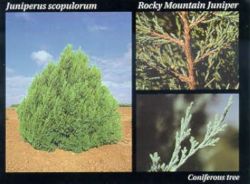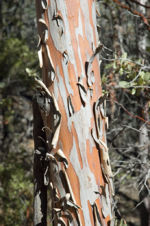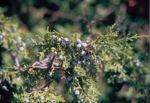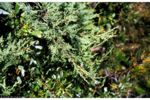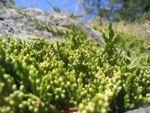Rocky mountain juniper
| Rocky mountain juniper |
|---|

|
| Scientific Classification |
|
| Binomial Name |
|
Juniperus scopulorum |
The Rocky Mountain Juniper is a coniferous shrub known by the species name Juniperus scopulorum. This plant has a very distinctive bark and its branches often develop huge outgrowths of of branches called a witch's broom. It is the only juniper that can grow to be the size of a small tree.[1]
The first people to have used this juniper found that the "berries" are very useful for making a kind of tea that would work as a stomach ailment. You do, however, need to be extremely cautious if you ever try this because it is not the safest thing to do. They also used these "berries" as an air freshener, disinfectant, and even as an aid in smoking animal skins! [2]
Anatomy
The Rocky Mountain Juniper is a shrub, that can grow from 3 to 30 feet tall. This shrub has more of a "Christmas Tree" shape than other types of junipers.[3] The trunk of this shrub is very unique because it twists and turns in strange shapes. The bark on this shrub is a reddish-brown color. The characteristics of the bark is that it is narrow, with flat pieces broken into shredded, stringy strips. The wood is durable, has a very fine texture, and is often knotty because of the way the tree grows.[4]
The leaves look and feel sort of like scales. They barely overlap, but cover the twig in four rows. On the younger, faster growing branches, the leaves are longer and look more like needles, scattered in rows of two's and three's. When young, the leaves are a yellow-green color, and turn to a greyish-green as they get older.[5]
Reproduction
The male and female cones are located on separate trees. The female cones are not able to reproduce the first year and are in a solitary state at the tips of the branchlets. Mature cones look like berries. They could be described as fleshy and gummy, and normally a bright blue to a purple kind of color. They are covered with a white substance that easily gets wiped off.[6] These berries have a gin kind of scent. Because the berries do not ripen until the second season, you can occasionally see two or more generations of these berries on the same tree.[7] The rocky mountain juniper pollinates during April and May, and "berries" grow from October to December after the second year of pollination.[8]
Ecology
This tree shrub is often found in open areas of the same tree and is sometimes seen mixed with ponderosa pines and Douglas firs.[9] This plant grows in dry areas for the most part and is rarely seen in most places. This tree shrub grows best on exposed bluffs, ridge tops, ravines, and canyons. The elevation levels for this tree are between 5,000 and 9,000 feet.[10]
Uses
The Rocky Mountain Juniper has been found useful in many different aspects. Today, the wood is used for carving and cooking. There are also many traditional uses. The wood is usually carved into bows, clubs, spoons, and other various objects. The boughs are used as a disinfectant, air freshener, in sweet houses, and for smoking animal hides. Lastly, the berries are used for making a tea (the stomach ailment), and as an ingredient for cooking.[11]
Animals that find this shrub as a perfect place for shelter are elk, mule deer, whitetail deer, bighorn sheep, and antelope. Some animals that consume the "berries" for food are migratory birds, turkeys, and other upland game birds. Some of the disadvantages for the Rocky Mountain juniper is that it's not a desired foliage plant for livestock and may cause spontaneous abortion.[12]
 Browse |
Related References
